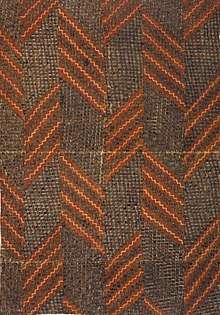Kapa
Kapa is a fabric made by native Hawaiians from the bast fibres of certain species of trees and shrubs in the orders Rosales and Malvales.
.jpg)
Description and uses

It is similar to tapa found elsewhere in Polynesia, but differs in the methods used in its creation. Kapa is based primarily on the creative combination of linear elements that cross and converge to form squares, triangles, chevrons, and diagonal forms, giving a feeling of boldness and directness.[1] (The Hawaiian /k/ phoneme corresponds to Polynesian /t/.) Kapa was used primarily for clothing like the malo worn by men as a loincloth and the pāʻū worn by women as a wraparound. Kapa was also used for kīhei used over the shoulders. Other uses for kapa depended on caste and a person's place in ancient Hawaiian society.
Kapa moe (bed covers) were reserved for the aliʻi or chiefly caste, while kapa robes were used by kāhuna or priestly caste. Kapa was also used as banners where leis were hung from it and images of their gods were printed on it.[2]
Techniques
Cultural anthropologists over the course of the 20th century identified techniques in the creation of kapa that are unique to the Hawaiian Islands. Wauke (Broussonetia papyrifera) was the preferred source of bast fibres for kapa, but it was also made from ʻulu (Artocarpus altilis),[3] ōpuhe (Urera spp.),[4] maʻaloa (Neraudia melastomifolia),[5] māmaki (Pipturus albidus),[6] ʻākala (Rubus hawaiensis), ʻākalakala (R. macraei), and hau (Hibiscus tiliaceus).[7] In the 18th century, pieces of kapa were often made of grooving or ribbing. It is done by pushing the dampened cloth into the grooves of a special board.[8] The wauke tree is cut and soaked in water. It is then laid on a kua kūkū (polished stone tablet) and beaten with a hōhoa (rounded beater). After the first phase of beating, the kapa is transferred to a sacred house to be beaten a second time, but in a religious manner.
Process
Each kapa manufacturer used an ʻiʻe kūkū, a beater with four flat sides that were each carved differently. Another way to carve the kapa is by starting on the four-sided affairs, with the coarsest grooves on one side used first in breaking down the bast, or wet bark. Then, the beating continued using two sides with finer grooves. Lastly, finishing touches were accomplished with the remaining smooth side of the beater.[9] The carvings left an impression in the cloth that was hers alone. After the European discovery of the Hawaiian Islands, Western traders travelled to Hawaiʻi especially for kapa.
The process of making kapa was done primarily by women. Young girls would learn by helping their mothers, over time doing the majority of the work, and when older could make kapa by themselves.[10]
See also
- Tapa cloth, similar fabric made elsewhere in Polynesia
References
- Kaeppler, Adrienne L. (1980). Kapa: Hawaiian Bark Cloth. Honolulu: Boom Books. p. 1.
- Kuykendall, Ralph Simpson (1938). The Hawaiian Kingdom: Volume 1. University of Hawaii Press. p. 8.
- "ʻulu". Hawaiian Ethnobotany Online Database. Bernice P. Bishop Museum. Archived from the original on 2007-07-02. Retrieved 2009-03-12.
- "opuhe, hopue (A. glabra), hona (U. glabra)". Hawaiian Ethnobotany Online Database. Bernice P. Bishop Museum. Archived from the original on 2007-07-02. Retrieved 2009-03-12.
- "maaloa, maoloa". Hawaiian Ethnobotany Online Database. Bernice P. Bishop Museum. Archived from the original on 2007-07-02. Retrieved 2009-03-12.
- "mamaki, mamake, waimea (P. albidus on Kauai & P. ruber)". Hawaiian Ethnobotany Online Database. Bernice P. Bishop Museum. Retrieved 2009-03-12.
- "Native Plants of Hawaiian Dry Forests and Traditional Uses for Them" (PDF). Hawaiʻi Forest Industry Association. Archived from the original (PDF) on 2011-07-26. Retrieved 2009-03-12.
- Kaeppler, Adienne L. (1980). Kapa: Hawaiian Bark Cloth. Honolulu: Boom Books. p. 4.
- Fullard-Leo, Betty (June 1998). "Kapa". Coffee Times. Retrieved 2010-11-09.
- Dunford, Betty; Andrew, Lilinoe; Ayau, Miki'ala; Honda, Liana I.; Williams, Julie Stewart (2002). The Hawaiians of Old (3rd ed.). Honolulu, Hawaii: Bess Press Inc. p. 48. ISBN 1573061379.
Further reading
- Arkinstall, Patricia Lorraine (1966). A study of bark cloth from Hawaii, Samoa, Tonga and Fiji: an exploration of the regional development of distinctive styles of bark cloth and its relationship to other cultural factors. Ithaca, N.Y.: Cornell University.
- Brigham, William Tufts (1911). Ka hana kapa, the making of bark cloth in Hawaii. Honolulu, Hawaii: Bishop Museum Press.
- Kaeppler, Adrienne Lois (1975). The Fabrics of Hawaii (Bark Cloth). Leigh-on-Sea, England: F. Lewis. ISBN 9780853170365.
External links
| Wikimedia Commons has media related to Kapa. |
- Cook-Foster Collection at Georg-August University in Göttingen, Germany
- Kapa Connection
- Hawaiian Kapa Making
- Hawaiian Kapa History
- Contemporary Hawaiian Kapa
- "Kapa: Fabric of a Culture" Article about the art of kapa making and kapa master Pua Van Dorpe by Rita Goldman. Maui No Ka 'Oi Magazine Vol.12, No.1 (January 2008)
- "Kapa: More to Learn" Pua Van Dorpe's kapa collection honoring 11 Maui chiefs. Maui No Ka 'Oi Magazine Vol.12, No.1 (January 2008)